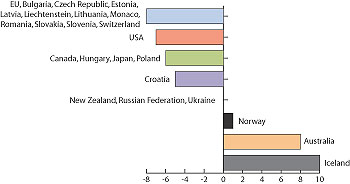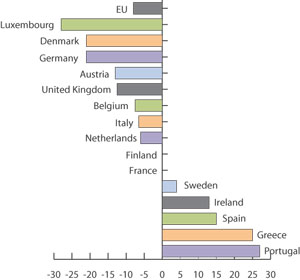 > English > Climate Encyclopaedia > People Changing Climate > more > 3. How to hinder climate change > - Kyoto Protocol
> English > Climate Encyclopaedia > People Changing Climate > more > 3. How to hinder climate change > - Kyoto Protocol
|
people changing the climate? |
3. How can we hinder man-made climate change?
The Kyoto ProtocolIn 1997, the Climate Convention held a conference in Kyoto, Japan. The aim of the conference was to achieve agreement on a treaty that would require the industrialised world to limit its emissions of greenhouse gases. An agreement was made to set targets for reductions of industrialised countries’ emissions of greenhouse gases: the Kyoto Protocol. It requires that industrialised countries, as a group, reduce their emissions of six greenhouse gases by about 5% compared to 1990 levels in the period 2008–2012. This agreement is legally binding. This means that states that have agreed to its terms and then fail to live up to their commitments will be sanctioned – including by having to reduce their emissions even more in a subsequent period. But states that withdraw from the entire agreement cannot be sanctioned.
|
|
The 5% reduction in emissions required by the Protocol is an average: some countries are required to reduce more, and others less. The quotas and targets assigned to each country were arrived at through many rounds of tough negotiations. This figure shows how different countries must reduce their emissions compared with 1990.
|
The Kyoto Protocol covers the following gases:
|
|
|
The agreement allows states to meet their targets in other ways than by simply reducing emissions domestically. Three so-called flexibility mechanisms were established to help states reduce their costs in meeting targets:
The Kyoto Protocol enters into force as soon as it has been ratified by at least 55 countries. Industrialized countries that together represent at least 55 percent of the CO2 emissions in 1990 must be included among the ratifying countries for the agreement to enter into force. The United States has declared that it will not ratify the agreement. The Kyoto Protocol, in its current form, will have a minimal effect on global emissions of greenhouse gases in the period 2008–2012. The Protocol was especially weakened after the United States, with its high emissions, withdrew its support. The Kyoto Protocol will probably make only a slight difference, partly because several countries with economies in transition – particularly Russia – have already reduced their emissions dramatically from 1990 levels for economic reasons. But soon negotiations for new commitments for the period after 2012 will begin. If agreement is reached on even stricter targets after 2012, and if the United States and developing countries eventually take on commitments, the agreement can become more effective. So even though the Kyoto Protocol is perhaps only a small step for the Earth’s climate, it may be a necessary first step on the road to more effective international climate co-operation.
|
|
Back to Basics-section About this page:Author: Camilla Schreiner - CICERO (Centre for International Climate and Environmental Research - Oslo) - Norway.
|


